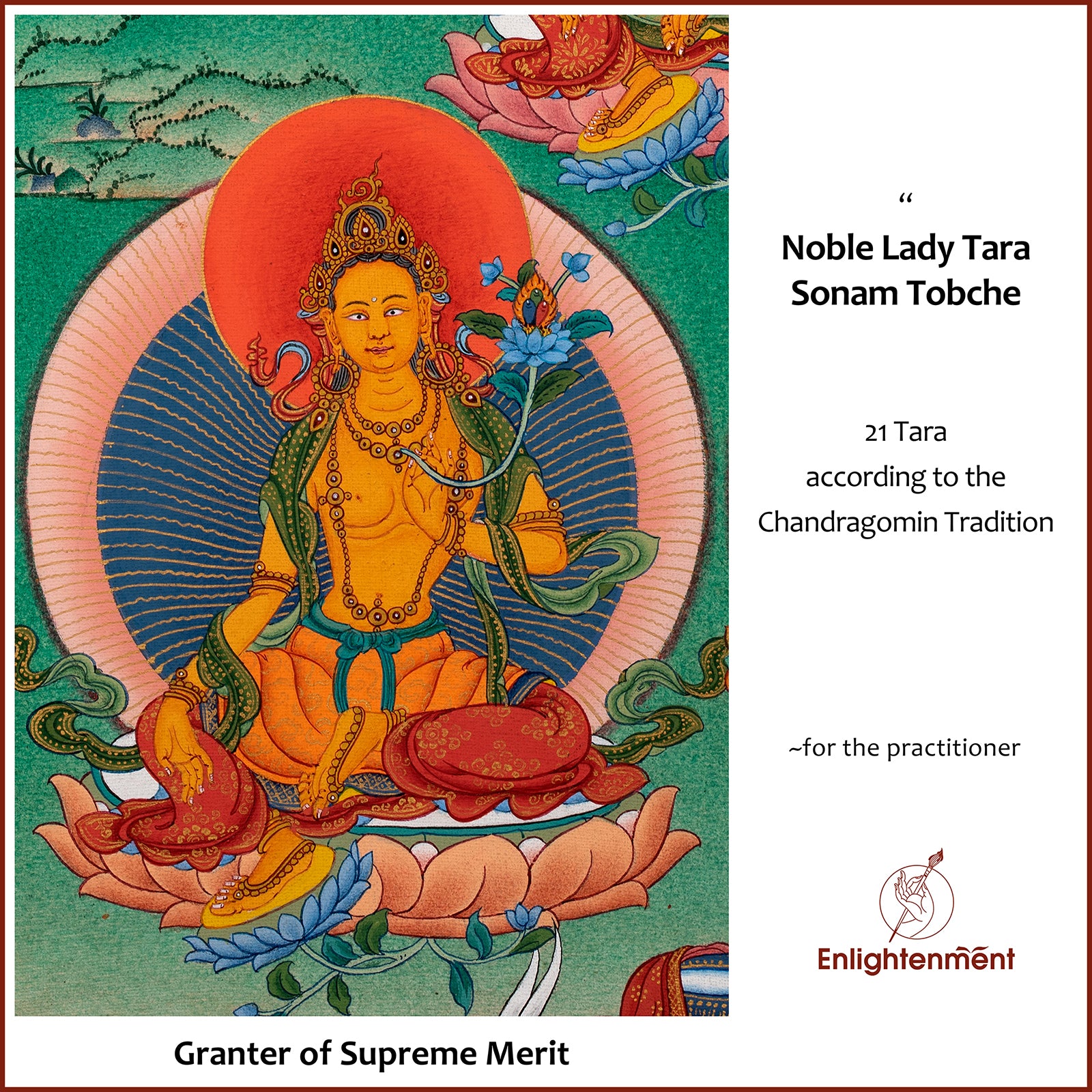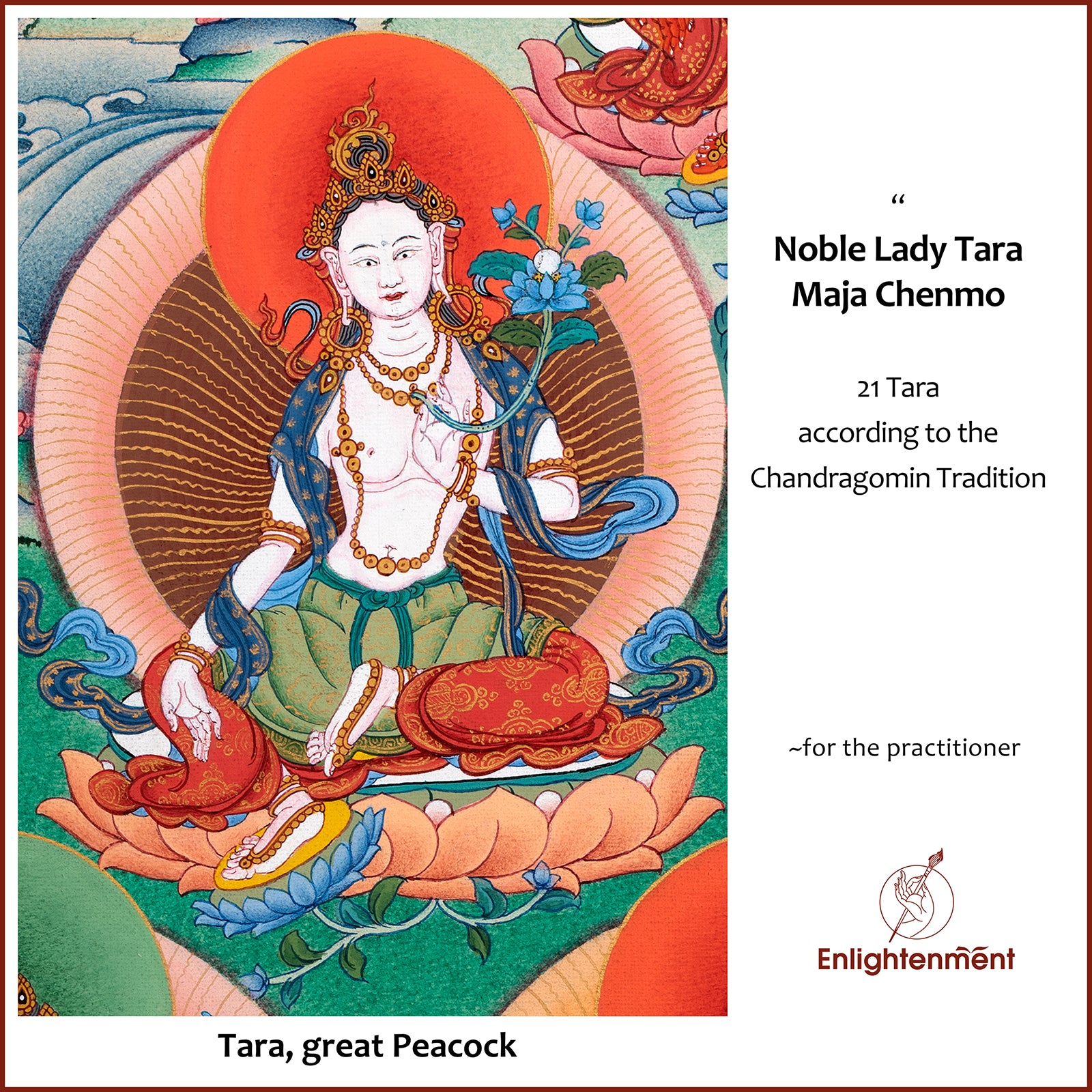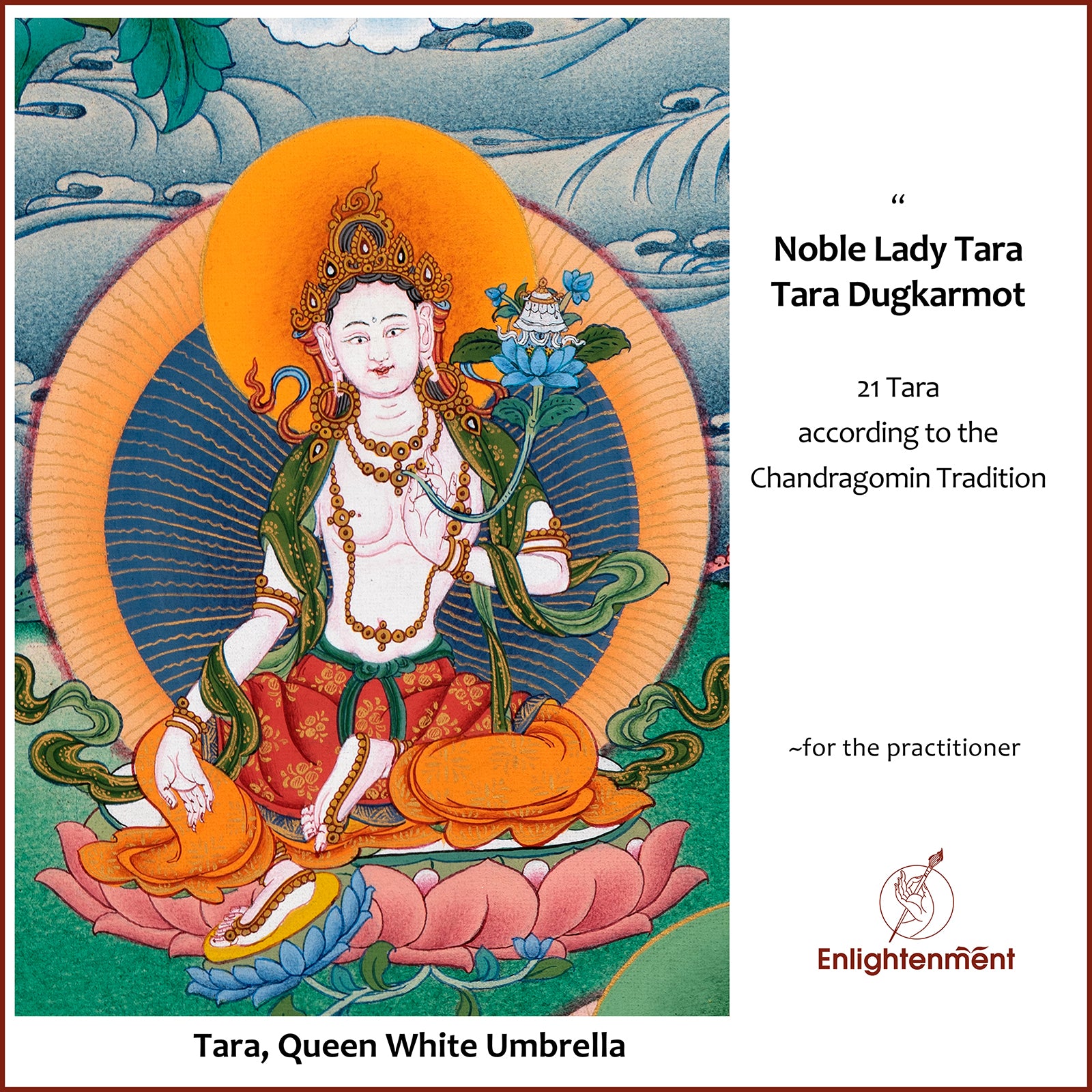The specific practice called "Praises to the 21 Tara"
We see and practice 21 Tara, each with different names, colors, and attributes. There are various sets of 21 Tara depending upon the narration of different tradition and lineages:
View the different sets of 21 Tara by clicking here:  One might asks, "Why 21 Tara in specific? And not 22 or 23 or 40 or any random numbers?"
One might asks, "Why 21 Tara in specific? And not 22 or 23 or 40 or any random numbers?"
At the basic level, Buddha have taught us 21 techniques with which we are able to attain Enlightenment. According to the Mahayana Sutra system, as we practice we traverse the ten different levels (Bhumis), eventually reaching the enlightened state. The basis for our enlightenment is right where we find ourselves now, with the precious endowment of our own human body and our own buddha-nature.
Vajrayana or Tantra is similar to the sutra system, but its methods are more specifically targeted. According to tantric teaching, within this human body we have twenty one knots. These are in pairs and they obstruct or block our channels. Through practice, as we release each of these pairs of knots, we obtain a specific experience or realization.
After we have released all of the 21 knots, we are known as enlightened beings, having attained Buddhahood.
Buddhahood is not some force that is outside us, waiting for the knots to be untied in order to come in. From basic Buddhism all the way to Dzogchen, it is made perfectly clear that Buddhahood is an innate state, already within us.
Our inherently awakened state is an already enlightened being, a Buddha, Tathagatagarbha. When we release those 21 knots, we attain the ultimate awakening known as the Dharmakaya state.
The Dharmakaya, in turn has 21 spontaneously inherent qualities. They transcend duality, the compound state, permanence and impermanence, and effort or striving. Unceasingly, they arise as necessary for the benefit of all sentient beings.
These twenty one active Dharma kaya qualities appear as the twenty one emanation of Tara. Thus Tara combines all the active energies of the three kayas by which we release our own knots and those of other beings, the energy by which we achieve enlightenment and help other beings to achieve it.
To Purchase our collection of 21 Tara Thangka Prints Click Here:
Praises to 21 Tara : The Chandragomin Tradition
The Praise to Tara with Twenty-One Verses of Homage, and the Excellent Benefits of Reciting the Praise is usually abbreviated to Praises to the Twenty-One Taras. It is a twenty-seven-versed tantra that is dedicated to the female Bodhisattva Tara, who has twenty-one emanations; ranging from peaceful to wrathful forms. These poetic verses describe her physical appearance, iconography, attributes, and mantra; and pay homage to the great Tara.
This article aims to provide general introductions to each of the twenty-one Taras so that the new practitioner can gain a rudimental understanding of these emanations, based on the Chandragomin tradition.
What are the 21 forms of Tara?
1. Noble Lady Tara Nyurma Pamo
The first Tara is called Jetsun Drolma Nyurma Pamo in Tibetan, which can roughly be translated to “the liberator,” “the swift one,” or alternatively, “the heroine.” The instruction of kye rim, which is the stage of development, teaches us the correct way to visualize and meditate on Tara. It is initiated by visualizing the Tara right in front of us. After having stabilized the visualization, we then visualize her dissolving into us, and we, so to speak, become Tara. 2. Noble Lady Tara Loter Yangchenma
2. Noble Lady Tara Loter Yangchenma
The second Tara is named Loter Yangchenma, and the name has multiple meanings, including “the knowledge-giver,” “the one who possesses melodies,” and “the source of melodies.” So, she is also known as Drolma Loter Yangchenma, as in “the melodious liberator and the source of wisdom.” She is called ‘Sarasvati’ in Sanskrit. We use the method of generating visualization, where instead of mere intellectual analysis exercise, we are also taught practices that help us discover our true nature, and that of others.
3. Noble Lady Tara Sonam Tobche
The third Tara is known as Tara Sonam Tobche, where Sonam is translated as “merit,” “good fortune,” “prosperity,” and even “luck.” As for Tobche, the Tob stands for “power,” whereas Che means “ever-increasing.” Collectively, her name means “the liberator who increases the power of prosperity and ability of merit.” She is called ‘Vasudhari’ in Sanskrit. The purpose of practicing on her is not just limited to external and material wealth, but also to develop spiritual affluency. 4. Noble Lady Tara Tsugtor Namgyalma
4. Noble Lady Tara Tsugtor Namgyalma
The fourth Tara is called Tsugtor Namgyalma or, at times, Tsugtor Nampar Gyalma. She is also famous as ‘Ushnishtavijaya’ in Sanskrit. The term tsugtor in Tibetan, and ushnishta in Sanskrit refers to the topknot upon the crown of a Buddha. This topknot also happens to be one of the thirty-two major marks of a fully enlightened Buddha, so it holds a certain significance. The remaining part of her name means “the victorious one.” As such, her name means “the victorious one of the topknot.” The visualization process includes perceiving the lotus, moon disc, and Tara sitting atop with her iconography.
5. Noble Lady Tara Wangdu Rigje Lhamo
Wangdu Rigje Lhamo is the fifth Tara, who is Kurukulle in Sanskrit and Rigjema or Rigje Lhamo in Tibetan. The name means the power of “gathering, summoning, or magnetizing.” Her visualization practice is simply the interpretation of her name. She is the one who precisely understands the power of magnetizing. Therefore, we visualize Tara and manifest spirituality by virtue of the universal law of attraction.
6. Noble Lady Tara Jigje Chenmo
The name of the sixth Tara is Jigje Chenmo, where Jigje means “fierce and frightening,” and Chenmo means “the great one.” Therefore, she is the great, fierce Tara. We practice her empowerments so as to protect us from negative forces that disturb us, be it invisible or visible. We visualize her dark-red, almost black color as she sits on a lotus and moon disc, where she symbolizes the activity of subjugating.
7. Noble Lady Tara Zhengyi Mithubma
Zhengyi Mithubma is the seventh emanation of Tara, and the name means “the unconquerable one.” For her practice, we visualize her in her natural blue-black color, which reminds us of heavy rain clouds and dense smoke – it is supposed to radiate a rather intimidating aura since her name itself is for someone whom others cannot defeat. Visualizing the flames of wisdom surrounding her with darkness symbolizes the uncertainty and unassuming ferocity of existence.
 8. Noble Lady Tara Zhengyi Migyalma
8. Noble Lady Tara Zhengyi Migyalma
The eighth Tara is called Zhengyi Migyalma, and much like her name, its meaning is also similar to that of the preceding Tara, Zhengyi Mithubma. Zhengyi Migyalma means “the invincible one” as she is the lady against whom no one can win. For her visualization practice, we perceive her color like dark red. The center of the lotus has a flaming vajra, and upon visualizing it, we are greeted with a powerful blaze of wisdom light, and flames that burn and destroy all obstacles.
9. Noble Lady Tara Sengdeng Nagchi
The ninth Tara is the Green Tara Sengdeng Nagchi, who protects us from all external fears. She is also sometimes called Sengdeng Nagchi Drolma. Her name refers to a large tree, known as teak which is frequently used to make damarus and 'chod' drums from its strong, dense wood. This tree is inherently wrathful, but its bark, resin, and wood are very useful. Visualizing the Green Tara of the sengdeng forest begins with remembering the introductory prayers, the emerald green color, and the eight-spoked dharma wheel radiating wisdom.
10. Noble Lady Tara Jigten Sumle Gyalma
The name of the tenth Tara is Jigten Sumle Gyalma, which means “the Tara who gains victory over all the three worlds,” where her special power is to protect us against distraction by worldly activities. The process is initiated by devotion, appreciation, and bodhichitta, and continued with visualizing Tara’s iconography for the sole purpose of achieving realization.
11. Noble Lady Tara Phagma Norter Drolma
The eleventh Tara is named Pahgma Norter Drolma, where Phagma means “the noble or supreme one,” whereas Norter translates to “bestowing riches.” Therefore, Phagma Norter Drolma is the noble Tara who bestows wealth. By visualizing this Tara’s iconography with the regular color, lotus and moon disc, and the semi-wrathful expression, we can achieve the gifts of peace, joy, love, compassion, and ultimately, enlightenment. 
12. Noble Lady Tara Tashi Donje
The twelfth Tara is known as Tashi Donje. Tashi Donje means “the Tara who actualizes auspiciousness.” It is because the Tibetan word Tashi means “auspicious circumstances,” and Donje means “fulfilling or actualizing.” The visualization of this Tara is practiced for the purpose of bringing harmony and balance externally, and health and physical balance internally. We visualize her golden yellow color and the light that radiates from the upright eternal knot.
13. Noble Lady Tara Yulle Gyalma
The thirteenth Tara is Yulle Gyalma, and her name means “the Tara who gains victory over war.” She is famous for protecting against all the obstacles related to wars, where she can reverse the march of armies or even stop the war completely. Metaphorically, her protection also implies inwardly as she stops hostile emotions born of conceptual thinking that plague our awareness and lead us to warlike actions. Her visualization leads to making conscious choices and keeping our harmful emotional tendencies in check.
14. Noble Lady Tara Thronyer Chen
Tara Thronyer Chen is the fourteenth Tara. Since Thronyer means “frowning and wrathful,” she is the wrathful and frowning one. Her visualization atop the lotus and disc leads to the removal of obstacles due to misleading influences, which are usually our most stubborn obstacles. She deals with the last couple of our delusions that is present deep within the elemental nature of human beings. This is why her color is a dark, blackish, rain cloud shade.
15. Noble Lady Tara Rabzhima
The fifteenth Tara is Rabzhima, who is also known as the Tara of purification. Rabzhima means “supremely peaceful,” and parallel to that, her special activity is purifying our serious errors and greater obscurations. With the supreme bodhichitta motivation, we visualize Tara in a rich white color, like the full autumn moon. Her expression is peaceful and smiling, and she holds a blue lotus wherein there is a vase in the center; it is filled with nectar anointing.
16. Noble Lady Tara Rigngag Tobjom
The sixteenth Tara is called Rigngag Tobjom. Her unique ability is to stop the negative intentions of others, such as spells and curses. Rigngag has several meanings and interpretations, but in this context, it refers to the misuse of mantras or the other aspects of practice for evil purposes or to cause others harm. Therefore, the meaning of her name is “the Tara who destroys the power of bad intentions.” After having done the “Seven Line Prayer” and lineage prayer, we feel the presence of Tara in the pure land of Potala and we visualize her in the space.
17. Noble Lady Tara Pagme Nonma
Tara Pagme Nonma is the seventeenth Tara who protects us against the obstacles associated with robberies, gangsters, and hunters. Pagme means “immeasurable and countless” and Nonma means “stopping.” Therefore, she is the Tara who stops countless violent activities. Her visualization practice also helps us reach a state of calmness and tranquility as she is the Tara of non-violence.
18. Noble Lady Tara Maja Chenmo
The eighteenth Tara is Tara Maja Chenmo. Mayura is Sanskrit for peacock, which is maja in Tibetan. The symbolism can be drawn simply, as peacocks are said to eat poison and turn it into the beauty of its plumage, and with that in mind, Tara’s special quality is counteracting or dispelling inner and outer poisons. She is visualized in the white color of a glacier mountain touched by the autumn moon, and the special ten-syllable action mantra is recited.
19. Noble Lady Tara Dugkarmo
The nineteenth Tara is Tara Dugkarmo, who protects us from nightmares, bad omens in our dreams, and black magic. Dugkar means “white umbrella,” and so she is often called Queen White Umbrella. Her visualization practice protects the Dharma and the Lamas from spiritual harm. It also protects us from arguments, chaos, and violence. She is visualized in white and her facial expression is passionate and smiling, but simultaneously semi-wrathful.
20. Noble Lady Tara Rito Loma Jonma
Tara Rito Jonma is the twentieth emanation of Tara. She is known for giving us protection from contagious diseases, plagues, epidemics, and fevers. Rito can roughly be translated to “mountain hermitage,” and Loma means “leaves of a tree,” and Jonma means “wearing.” She is also called Parnashavari. She is hence the Tara wearing the leaves of a tree in her mountain retreat. She is visualized in a golden-red or saffron color with the usual posture and mudra, where she holds a blue lotus flower on which there is a container full of medicinal substances.
21. Noble Lady Tara Lhamo Ozer Chenma
The twenty-first Tara is Tara Lhamo Ozer Chenma. She is the divine Great Mother of “brilliant light rays.” She can protect our longevity so she is particularly beneficial to us. When our energy, vitality, or life force is endangered, she is the Tara who helps us. We visualize her color as a rich white; in her hand, she holds a blue lotus upon which stands a golden fish. Wisdom light emanates from the fish and summons back all the vitalities and energies that have been lost by us.
To Purchase the high quality thangka print of this beautifully hand painted 21 Tara of Chandragomin Tradition:
Reference for 21 Tara:
P. S. Rinpoche, and K. T. D. Rinpoche (2007). Tara’s Enlightened Activity: An Oral Commentary on The Twenty-one Praises to Tara


2 comments
Tsering Dolma
I am a crazy devotee of Jetsun Drolma la (TARA)
What ever I am is all by the GRACE of Jetsun Drolma la
Immense of Thank you so much from debt of my heart to have a great briefly explained… I really appreciated from heart
With respect and Highly appreciated
🙏🏻🙏🏻🙏🏻✨✨✨✨✨✨✨🙏🏻
Karma Sange
Green Tara solves disputes between people. If you aren’t getting along with someone, do the 21 praises, then her mantra…all the time with the intent that she is mitigating the problem.